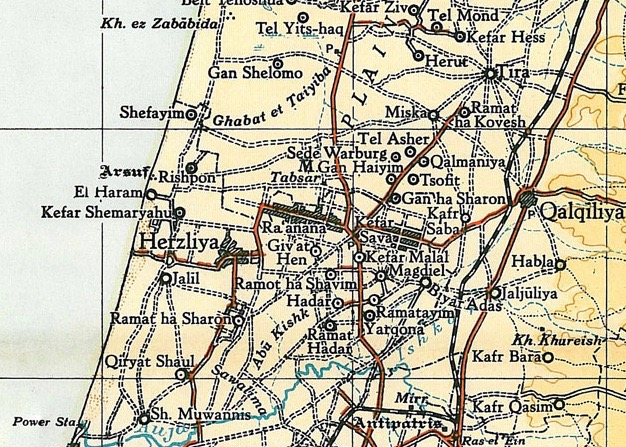Tabsur on:
[Wikipedia]
[Google]
[Amazon]
Tabsur ( ar, تبصر), also Khirbat 'Azzun ( ar, خربة عزون), was a
21
/ref> 29 dunams were classified as built-up (urban) area.Government of Palestine, Department of Statistics. ''Village Statistics, April, 1945.'' Quoted in Hadawi, 1970, p
177
/ref>

245
/ref> The villagers left on 16 April 1948.
Welcome To TabsurTabsur (Khirbet 'Azzun)
IAAWikimedia commons
{{Palestinian Arab villages depopulated during the 1948 Palestine War Arab villages depopulated prior to the 1948 Arab–Israeli War District of Tulkarm
Palestinian
Palestinians ( ar, الفلسطينيون, ; he, פָלַסְטִינִים, ) or Palestinian people ( ar, الشعب الفلسطيني, label=none, ), also referred to as Palestinian Arabs ( ar, الفلسطينيين العرب, label=non ...
village located 19 kilometres southwest of Tulkarm. In 1931, the village had 218 houses and an elementary school for boys. Its Palestinian population was expelled during the 1948 Arab-Israeli war
Events January
* January 1
** The General Agreement on Tariffs and Trade (GATT) is inaugurated.
** The Constitution of New Jersey (later subject to amendment) goes into effect.
** The railways of Britain are nationalized, to form Britis ...
.
History
Tabsur was established before the middle of the nineteenth-century on an archaeological site.Khalidi, 1992, p. 561 The village contained archaeological remains, including the foundations of a building, a well, fragments ofmosaic
A mosaic is a pattern or image made of small regular or irregular pieces of colored stone, glass or ceramic, held in place by plaster/mortar, and covering a surface. Mosaics are often used as floor and wall decoration, and were particularly pop ...
pavement, and tombs.Khalidi, 1992, p. 562
In the late nineteenth century, Tabsur was described as a moderate-sized hamlet
''The Tragedy of Hamlet, Prince of Denmark'', often shortened to ''Hamlet'' (), is a tragedy written by William Shakespeare sometime between 1599 and 1601. It is Shakespeare's longest play, with 29,551 words. Set in Denmark, the play depicts ...
with a well to the north. It was later classified as a hamlet by the ''Palestine Index Gazetteer''.British Mandate era
During the British Mandate an elementary school for boys was established in the village. The village also had a few shops. In the1922 census of Palestine
The 1922 census of Palestine was the first census carried out by the authorities of the British Mandate of Palestine, on 23 October 1922.
The reported population was 757,182, including the military and persons of foreign nationality. The divis ...
there were 709 villagers; 700 Muslims and 9 Christians, (where the Christians were all Orthodox,) increasing in 1931 census to 994; 980 Muslims and 14 Christians, in 218 houses.
In the 1944/45 statistics, a total of 1,602 dunums were allocated to cereals, while 24 dunums were irrigated or used for orchards.Department of Statistics, 1945, p21
/ref> 29 dunams were classified as built-up (urban) area.Government of Palestine, Department of Statistics. ''Village Statistics, April, 1945.'' Quoted in Hadawi, 1970, p
177
/ref>


1948, aftermath
TheArabs
The Arabs (singular: Arab; singular ar, عَرَبِيٌّ, DIN 31635: , , plural ar, عَرَب, DIN 31635: , Arabic pronunciation: ), also known as the Arab people, are an ethnic group mainly inhabiting the Arab world in Western Asia, ...
of Tabsur were ordered to leave by the Haganah
Haganah ( he, הַהֲגָנָה, lit. ''The Defence'') was the main Zionist paramilitary organization of the Jewish population ("Yishuv") in Mandatory Palestine between 1920 and its disestablishment in 1948, when it became the core of the I ...
on 3 April 1948, as part of Haganas policy of clearing out the Arab villages on the coastal plain.Morris, 2004, p245
/ref> The villagers left on 16 April 1948.
Ra'anana
Ra'anana ( he, רַעֲנָנָּה, lit. "Fresh") is a city in the southern Sharon Plain of the Central District of Israel. It was founded in 1922 as an American-Jewish settlement, 1 km south of the village of Tabsur, where an important ...
was established south of Tabsur in 1921. Now a city, some of its suburbs have expanded into land that once belonged to the village. Batzra
Batzra ( he, בָּצְרָה) is a moshav in central Israel. Located in the Sharon plain near Ra'anana, it falls under the jurisdiction of Hof HaSharon Regional Council. In it had a population of .
History
Before the 20th century the area for ...
, founded in 1946 on village land, lies to the north.
In 1992, the Palestinian historian Walid Khalidi
Walid Khalidi ( ar, وليد خالدي, born 1925 in Jerusalem) is an Oxford University-educated Palestinian historian who has written extensively on the Palestinian exodus. He is a co-founder of the Institute for Palestine Studies, establish ...
wrote: "The village has been completely covered with Israeli citrus orchards, making it difficult to distinguish from the surrounding lands. Citrus and cypress trees grow on the village land."
The estimated number of Palestinian refugee
Palestinian refugees are citizens of Mandatory Palestine, and their descendants, who fled or were expelled from their country over the course of the 1947–49 Palestine war (1948 Palestinian exodus) and the Six-Day War (1967 Palestinian exodu ...
s from Tabsur in 1998 was 2,406.
See also
* Azzun * Depopulated Palestinian locations in IsraelReferences
Bibliography
* * * * * * * *External links
Welcome To Tabsur
Zochrot
Zochrot ( he, זוכרות; "Remembering"; ar, ذاكرات; "Memories") is an Israeli nonprofit organization founded in 2002. Based in Tel Aviv, its aim is to promote awareness of the Palestinian ''Nakba'' ("Catastrophe"), including the 1948 Pa ...
*Survey of Western Palestine, Map 10IAA
{{Palestinian Arab villages depopulated during the 1948 Palestine War Arab villages depopulated prior to the 1948 Arab–Israeli War District of Tulkarm